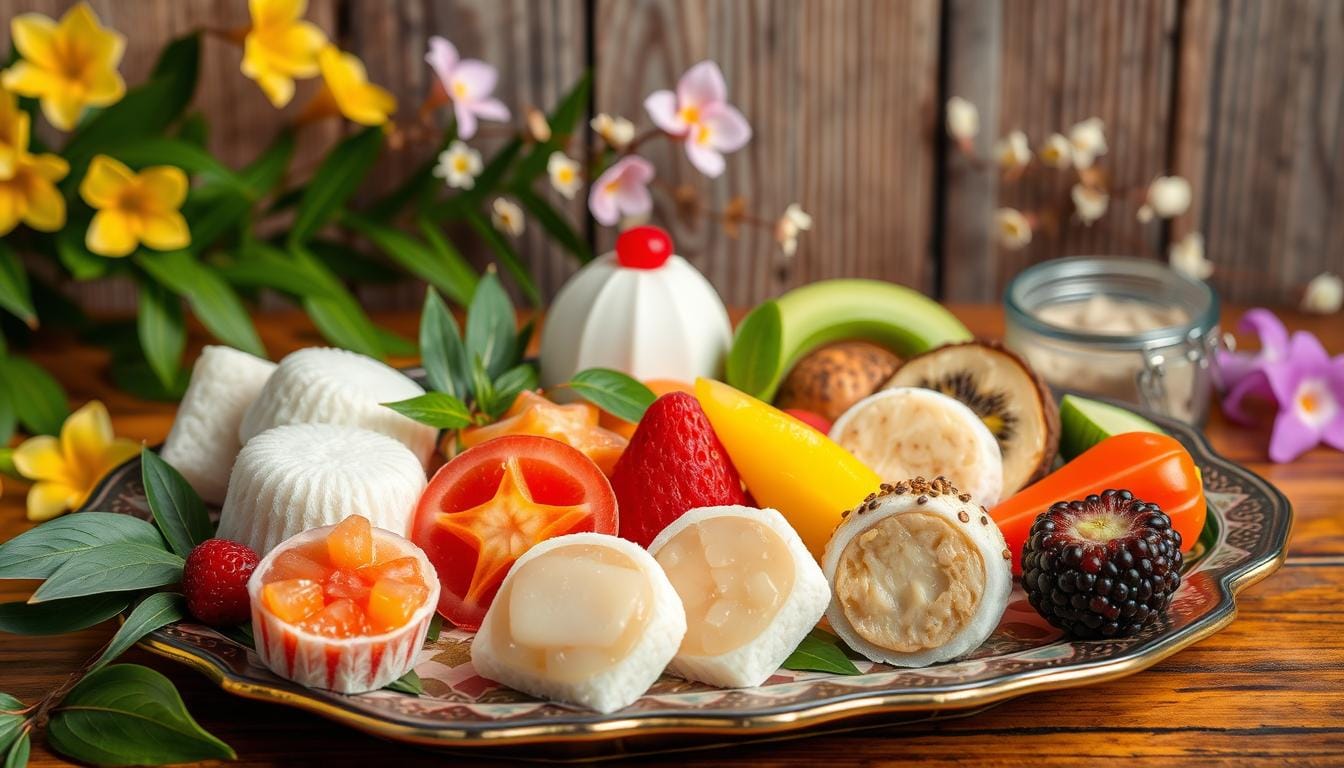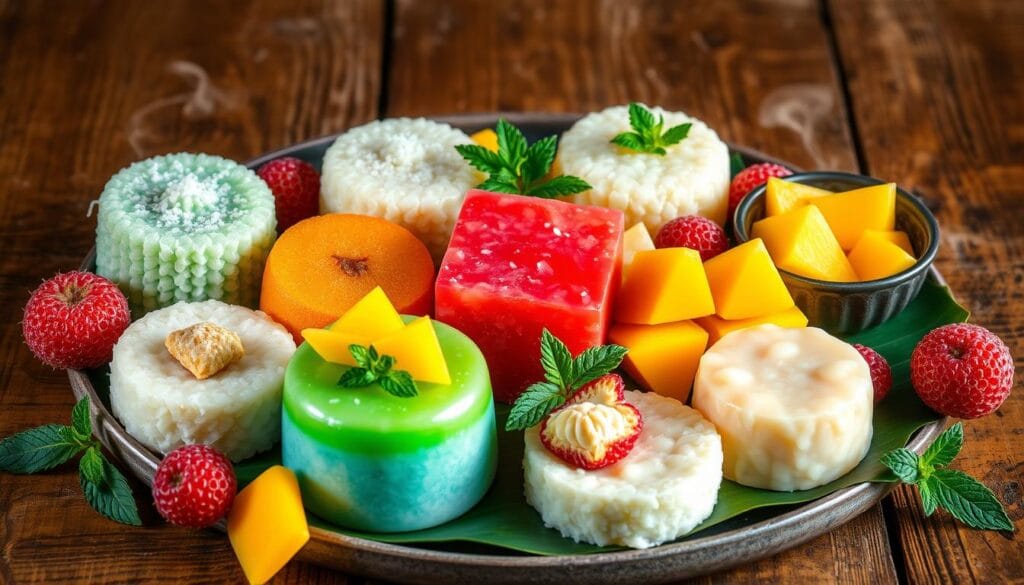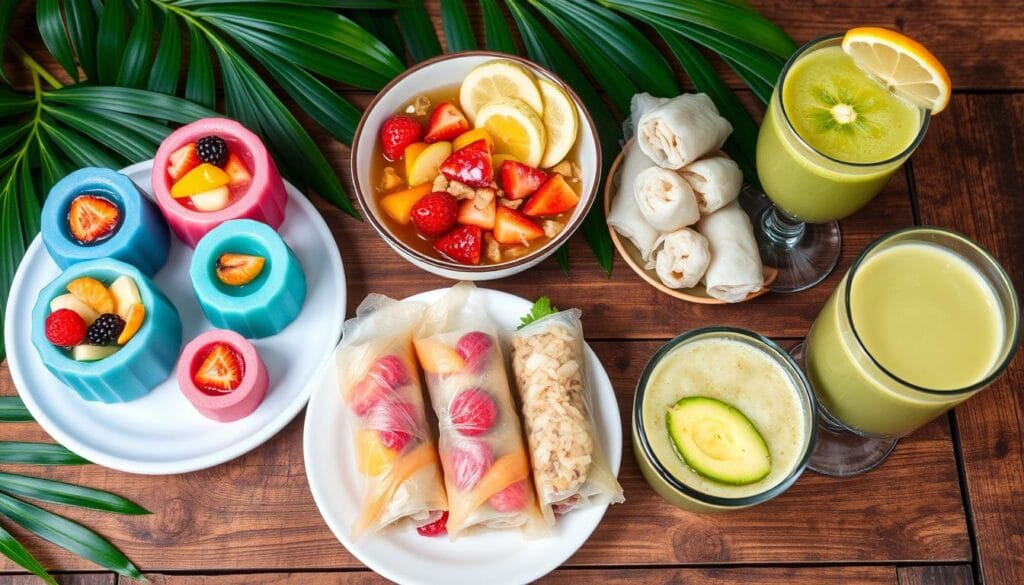As the sun sets over Vietnam, the air is filled with sweet smells. The country’s markets and cafes show off its rich dessert culture. You’ll find everything from creamy puddings to flaky pastries, each with its own unique taste and texture.
Explore a world of true flavors with these traditional Vietnamese sweets. Try the famous Chè Trôi Nước and the delicious Bánh Chuối Chiên. Each dessert has its own story, blending ingredients in a way that’s truly special.
Start a sweet adventure and find the hidden treasures of Vietnamese desserts. You’ll love the flavors, textures, and traditions that have won hearts everywhere. Let’s explore the secrets behind these irresistible treats.
The Rich History of Vietnamese Desserts
Vietnamese desserts are a big part of the country’s rich culinary history. They come from a mix of Chinese and other Asian traditions. Each region in Vietnam has its own special desserts, from hot treats in the north to coconut sweets in the Mekong Delta.
Traditional Influences on Vietnamese Sweets
Many Vietnamese desserts have been around for centuries. They are closely tied to Chinese cooking traditions. The north’s cooler weather means they often prefer hot, steamed, or boiled sweets.
Regional Variations in Dessert Styles
Traveling through Vietnam, you’ll find many different desserts. The Mekong Delta is famous for its coconut-based sweets, like che ba mau (three-color dessert). In Hanoi, you’ll find unique desserts like dried persimmon and green bean cake.
Vietnamese desserts show the country’s rich culinary heritage. They highlight the diversity and creativity of regional dessert traditions. Whether you like the warm desserts of the north or the tropical flavors of the south, there’s much to discover in Vietnamese sweets.
Popular Ingredients in Vietnamese Desserts
Vietnamese desserts are known for their unique flavors. They use coconut milk, sticky rice, and tropical fruits as main ingredients. These elements create the special taste and texture of Vietnamese sweets.
Coconut and Its Versatility
Coconut is a key ingredient in many Vietnamese desserts. It comes in forms like coconut milk and shredded coconut flesh. These add a rich flavor and creamy texture to desserts like banh khoai mi nuong and che chuoi.
The Role of Rice in Sweets
Rice is a big part of Vietnamese desserts. Sticky rice is especially loved, used in banh tet and banh bo. Its soft texture and mild sweetness balance out many desserts.
Tropical Fruits That Delight
Vietnam’s warm climate brings forth many colorful fruits. Mango, banana, jackfruit, and others add sweetness and freshness. They’re found in desserts like che Thai and banh mi.
The choice and preparation of coconut milk, sticky rice, and tropical fruits make Vietnamese desserts special. They offer a taste of Vietnam’s rich culinary history.
Classic Vietnamese Desserts You Can’t Miss
Dive into the world of traditional Vietnamese desserts. Each bite shares a story of culture and skill. Try Che Bap, Banh It Tran, and Che Ba Mau for a taste of tradition.
Che Bap: Sweet Corn Pudding
Che Bap comes from Hoi An and is a sweet mix of corn, coconut milk, and tapioca pearls. It’s warm and comforting, celebrating the region’s harvests.
Banh It Tran: Sticky Rice Dumplings
Banh It Tran are festive and tasty, loved during special times in Vietnam. They have a chewy outside and a sweet mung bean filling, enjoyed by all.
Che Ba Mau: Three-Color Dessert
Che Ba Mau is a colorful and refreshing treat. It combines red beans, mung beans, and pandan jelly with coconut milk and ice. It’s a feast for the senses, showcasing Vietnamese sweets.
Unique Flavors of Vietnamese Sweets
Vietnamese desserts are known for their sweet and salty mix. This mix creates a rich taste experience. It’s like a journey of flavors, from sweet corn pudding with savory nuoc cham to herbal sweets.
The Balance of Sweet and Salty
One key feature of Vietnamese sweets is their sweet and salty balance. Chè bà ba from southern Vietnam is a great example. It has over ten ingredients, like salted eggs and coconut. The salty parts make the sweet ones pop.
Herbal Infusions: A Flavor Surprise
Vietnamese sweets often surprise with herbal flavors. Pandan leaves give desserts like Chè khúc bạch a vanilla scent. Ginger in Chè trôi nước adds a spicy kick that goes well with sweetness.
Textural Harmony in Desserts
The textures in Vietnamese desserts are just as exciting as the flavors. The chewy rice balls in Chè trôi nước are a perfect match for the smooth ginger syrup. The creamy coconut milk in Chè chuối gets a boost from peanuts and sesame seeds.
“The flavors and textures of Vietnamese desserts are a delightful symphony, orchestrating a captivating taste experience that lingers long after the last bite.”
Delightful Cold Desserts to Beat the Heat
As summer hits, people in Vietnam look for cool treats to escape the heat. Two favorites are Che Thai and Banh Flan.
Che Thai: Tropical Fruit Salad
Che Thai is a colorful fruit cocktail that highlights Vietnam’s tropical fruits. It mixes pineapple, mango, and papaya with jellies, shaved ice, and coconut milk. The fruits’ sweetness and the dessert’s cool texture make it a summer favorite.
Banh Flan: A Creamy Custard Delight
Banh Flan is Vietnam’s twist on crème caramel. It’s served cold, topped with ca phe sua da syrup and crushed ice. The creamy texture and coffee notes offer a refreshing break from the heat.
These refreshing desserts are perfect for Vietnam’s summer treats. They show the country’s love for fruit-based and ca phe sua da-inspired sweets that cool you down.
“Vietnamese desserts are a testament to the country’s vibrant culinary heritage, blending tropical flavors, traditional techniques, and a touch of innovation to create truly unique and refreshing treats.”
Traditional Festivals and Dessert Traditions
Vietnamese culture is deeply rooted in cultural celebrations. Desserts are a big part of these celebrations. The Moon Festival and Tet Nguyen Dan, the Lunar New Year, are two key festivals. They both feature traditional Vietnamese sweets.
Moon Festival and Its Sweet Treats
The Moon Festival is celebrated on the 15th day of the 8th lunar month. This usually happens in September or October. A highlight is the Banh Trung Thu, or mooncakes, with flavors like lotus seed and chocolate.
Tet Nguyen Dan: Lunar New Year Desserts
The Tet Nguyen Dan, or Lunar New Year, is very important in Vietnam. It usually happens in late January or early February. Families gather for a feast, including Banh Chung, a rice cake with mung bean and beef.
At Tet Nguyen Dan, there are also candied fruits, called Mut. They are sweet treats enjoyed with savory spring rolls and other dishes.
These cultural celebrations and festival foods are key to Vietnamese cuisine. They help keep the traditions alive, passing down flavors and stories to future generations.
Vegan and Healthy Vietnamese Dessert Options
Vietnam’s desserts are full of vegan and healthy choices. They suit many diets. Enjoy the tasty and nutritious sweets.
Fruit-Based Desserts to Try
Hoa Qua Dam is a colorful fruit dessert. It mixes tropical fruits like jackfruit, lychee, and longan with coconut milk. It’s refreshing and good for you.
Tofu Sweets: Nutritious and Delicious
Dau Hu is a tofu pudding with ginger syrup. It’s creamy and has a warm ginger taste. It shows how vegan desserts can mix with traditional Vietnamese flavors.
These healthy sweets show Vietnamese cuisine’s creativity. It offers both plant-based and dairy-free desserts. Vietnam’s desserts are perfect for everyone, from goi cuon lovers to those looking for a healthy treat.
“Vietnamese cuisine has a remarkable ability to cater to diverse dietary needs while preserving the authentic flavors that make it so beloved.” – Culinary Historian, Jane Smith
How to Enjoy Vietnamese Desserts at Home
It’s easy to bring the flavors of Vietnamese desserts into your kitchen. Just focus on using fresh, quality ingredients and learn a few key techniques. This way, you can make these delicious sweets right at home.
Key Tips for Preparing Sweets
When making Vietnamese desserts, balance the flavors well. Sweetness, richness, and savory notes are key to getting the taste right. Try different textures to find the perfect mouthfeel for your desserts.
Many desserts need steaming or simmering to enhance flavors. Learning to control cooking temperatures and times is crucial. This helps you get the right texture, whether it’s sticky rice dumplings or smooth corn pudding.
Essential Ingredients and Equipment
To make authentic Vietnamese desserts, use ingredients like coconut milk, tropical fruits, and rice flour. A steamer is vital for dishes like Banh It. A strong blender is also important for smooth puddings and jellies.
Feel free to try new ingredients and adjust recipes to your liking. Many Vietnamese desserts can be modified to use local produce and flavors. This keeps their essence while making them your own.
With creativity and the right techniques, you can make Vietnamese desserts at home. Focus on flavor balance, texture, and fresh ingredients. This way, you’ll create sweets that feel like a trip to Vietnam’s markets and homes.
Where to Find Authentic Vietnamese Desserts
Looking to try Vietnamese desserts? The United States has plenty of places to enjoy these tasty treats. In cities like San Jose, Houston, and Orange County, you’ll find bakeries and restaurants serving real Vietnamese desserts.
Best Vietnamese Bakeries Across the U.S.
Vietnamese bakeries across the country are experts in traditional pastries and cakes. They offer a variety of Banh, like flaky Banh Mi and fragrant Banh Xeo. For a true experience, look for bakeries that focus on desserts like Che (sweet soups) or Banh (cakes and pastries), often in Asian markets or food courts.
Exploring Vietnamese Restaurants for Desserts
Vietnamese restaurants in the U.S. also serve authentic desserts. They mix traditional sweets with their main dishes, letting you try a wide range of Vietnamese foods. Want a refreshing Che Thai or rich Banh Cam? Vietnamese restaurants offer a real taste of Vietnam’s dessert culture.
FAQ
What are some popular Vietnamese desserts?
Popular Vietnamese desserts include Che Bap (sweet corn pudding) and Banh It Tran (sticky rice dumplings). Che Ba Mau (three-color dessert) and Che Thai (tropical fruit salad) are also favorites. Don’t forget Banh Flan (Vietnamese crème caramel).
How do Vietnamese desserts differ from other desserts around the world?
Vietnamese desserts mix sweet and salty flavors uniquely. Herbal infusions like pandan and ginger add depth. The mix of chewy rice balls with smooth syrups is a key feature.
What are the key ingredients used in Vietnamese desserts?
Key ingredients are coconut milk, sticky rice, and tropical fruits like mango and banana. These ingredients are used in various ways, showing their versatility.
How are Vietnamese desserts influenced by the country’s history and culture?
Vietnamese desserts were shaped by Chinese cuisine, with some treats over hundreds of years old. Northern Vietnam loves hot desserts, while the Mekong Delta is famous for coconut sweets.
What role do traditional festivals play in Vietnamese dessert traditions?
Festivals like the Moon Festival and Lunar New Year are big for desserts. Special treats like Banh Trung Thu (mooncakes) and Banh Chung (sticky rice cakes) are eaten to celebrate and bring families together.
Are there any vegan or healthier options among Vietnamese desserts?
Yes, Vietnam has many vegan and healthy desserts. Options like Hoa Qua Dam (mixed fruit dessert) and Dau Hu (silken tofu pudding) are popular. They cater to different diets while keeping traditional flavors.
How can I enjoy authentic Vietnamese desserts at home?
To make Vietnamese desserts at home, use fresh ingredients like coconut milk and tropical fruits. You’ll need a steamer and blender. It’s all about balancing flavors and getting the right texture.
Where can I find authentic Vietnamese desserts in the U.S.?
Look for authentic Vietnamese desserts in cities with big Vietnamese communities. San Jose, Houston, and Orange County are good places. Visit bakeries and restaurants that specialize in Vietnamese sweets, often found in Asian markets or food courts.
What is a popular dessert in Vietnam?
Che is a popular Vietnamese dessert, often served as a sweet soup or pudding with ingredients like beans, tapioca, coconut milk, and jellies.
What is the famous Vietnamese cake?
Bánh Bò (Vietnamese honeycomb cake) is a famous, spongy, and slightly sweet cake with a unique chewy texture.
What is Vietnamese dessert called?
Vietnamese desserts are commonly referred to as “Chè” (sweet soups or drinks) or “Bánh” (cakes and pastries).
What is the Vietnamese dessert similar to mochi?
Bánh Dày is similar to mochi. It’s a chewy, glutinous rice cake often filled with mung bean paste or other sweet fillings.



